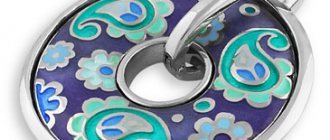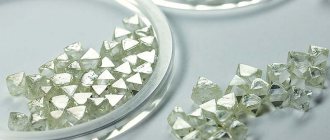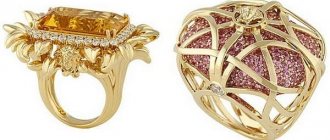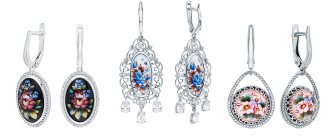It is called “fire writing”; in the 12th century this art was already widely developed in Rus' and could well compete with Byzantium
Enameling
Enamel
Enamel
Story
The art of artistic enameling has a history of more than two thousand years. In Ancient Rus', artistic enamel was called enamel, from the Greek word “fingitis”, which meant a light, shiny stone. This tradition was adopted by Russia from Byzantium.
"Jesus Christ", enamel miniature
The first period of flourishing of the enamel industry in Rus' occurred in the 11th – 12th centuries. The production of works decorated with enamel was concentrated in large cities, such as Kyiv, Chernigov, Galich, Vladimir, Ryazan, Novgorod.
“Crucifixion” Russia, XVIII century.
Artistic monuments of enamel art of Kievan Rus are currently stored in the largest museums in the country.
The political and economic reforms of Peter I led to a reorientation in all areas of science and art, as a result of which enamel painting at the beginning of the 18th century stood out from a number of craft types of work.
Icon "Savior on the Throne"
Enamel miniature becomes an independent art form, developing and improving the means of artistic expression used by miniature masters.
Types of enamels
- Miniature on enamel ( enamel ) is an artistic enameling technique that uses the technique of brush easel painting. The first registration of the image (underpainting) is carried out on a white enamel background of a copper base plate. After underpainting, the plate is dried, fired in a muffle furnace at 800 degrees and painted again. To obtain maximum color sophistication and detail of the design, the enamel artist repeats this process many times.
Enamel, “Bouquet of Flowers”
- Painted (picturesque) enamel - On the front side, the outline of the image and its details, for example, the face, hair, folds of clothing, are written in rich color enamel paint. To draw the outline of a drawing, a method of transferring a drawing from paper, the so-called “powder”, is also used. Since the enamel is applied in local fragments, firing is done 10-15 times, taking into account the different levels of melting temperature of the enamels used.
Altar cross. 16th century. Metal, enamel. Kirillo-Belozersky Monastery
- Cloisonne enamel - for its production, a thin metal plate is taken, on which the outline of the future image is scratched, engraved or cut through. Then thin metal strips are soldered along this contour, obtaining an image from cells of various shapes and sizes. Each cell is filled with enamel of a different color to the upper edge of the partitions and the enamel is fired. Complete filling of the cells with enamel, without recesses, is a distinctive feature of cloisonné enamels.
- Filigree enamel (filigree) - a floral or geometric ornament made of intertwined metal wire, which forms cells, is soldered (laid) onto a metal surface. Each cell is filled to the brim with enamel of a different color, which, after firing, settles and appears below the filigree ornament. As a result, filigree enamel is not polished. The lack of polishing and the enamel lying below the edge of the filigree partitions are the main differences between the filigree enamel technique.
Teapot with enamel pattern
- Champlevé enamel - a plot or ornamental image is deeply cut out (taken out) on a metal plate. The resulting depressions are filled with transparent or opaque enamel and the enamel is fired. In the champlevé enamel technique, several techniques are known to achieve an artistic effect.
- Engraving (carving) enamel is a type of champlevé enamel technique.
- Guilloche enamel is a variant of the engraving enamel technique. But engraving is done mechanically, using a special machine. In the guilloche enamel technique, exclusively transparent enamels of the widest range of colors are used.
- Enamel by casting - an image is obtained by casting it together with a metal base plate. Then the recess on the plate is filled with enamel.
Box with enamel, original work
- Relief enamel is a technique used for artistic enamel in high relief, when the enamel coating follows the shape of a metal relief image, acting as a glaze.
Rostov enamel
The most famous type of enamel art in Russia. Rostov enamel has its own history and artistic features unique to it.
You can purchase folk arts and crafts in the Russian Crafts store!
The “Russian Crafts” store is an online store of single and rare items, gifts and souvenirs of Russian folk art.
We offer traditional works of Russian folk art crafts, made by the best authors and craftsmen in different regions of Russia. We guarantee the authenticity of folk art, the exclusivity of the products presented and the uniqueness of each item.
Explore our offers
Share link:
- Click here to share content on Facebook. (Opens in a new window)
- Click to share on WhatsApp (Opens in new window)
- Click to share on Pinterest (Opens in new window)
- Click to share on Skype (Opens in new window)
- Click to share on Telegram (Opens in new window)
- Click to share on Twitter (Opens in new window)
- Click to share posts on Pocket (Opens in new window)
- Click to share on Reddit (Opens in new window)
- Click to share on LinkedIn (Opens in new window)
- Click to share posts on Tumblr (Opens in new window)
- Send this to a friend (Opens in new window)
- Click to print (Opens in new window)
History of the origin and development of the art of enamel
Painted enamel from Limoges
At the beginning of the 15th century. A completely new technique appeared - painted enamel. Using finely ground colored enamels, the image was applied to a single-color enamel base, and the paints were applied side by side without dividing partitions. Cornish tin, necessary for making enamel, was delivered from England (it gives opacity to paints that fuse during firing, which enhances their covering power). A special dye was brought from Spain - saphare, a natural mixture of cobalt oxide and sodium. Safra imparted purity and depth of tone to the famous blue enamel of the Limoges masters. Tin additions whitened the color and made it possible to use tonal nuances. These techniques were unknown to the masters of the previous period in the Meuse and Rhine regions. In Italy there were several workshops where this method was used, but still the center of development of new technology in the 15th-16th centuries. became the French city of Limoges. The technique of painted enamel flourished in the 16th century. in Limoges. The metal plate, the recipient, is also used as a painting base. Often made of copper, but also of iron, silver or gold, this plate is first of all covered entirely with a transparent glaze or a single-color opaque layer of enamel. Opaque glass masses are almost always used as enamel paints, which are applied with a marten brush to the primer and are subsequently fired. Since paints in the ground state often have a different tone than after firing, it is hardly possible to avoid repeated registration and firing. The reverse side of the plate is also mostly covered with a layer of enamel (counter-enamel) to prevent one-sided deformation of the metal during firing. Reliquary boxes, triptych altars, jugs, plates, and plaques were made in Limoges. Copper plates were painted with enamel paints with numerous - from ten to fifteen - intermediate firings. In this technique, paints cannot be mixed, otherwise the color will turn out dirty. Therefore, each paint layer is fixed with a separate firing. First, paints with a lower melting point (about 600°C) are fired, then with a higher one (800-900°C). Upon completion, the painting was covered with a thin layer of transparent enamel - fondon, which protects it from damage. The painting was also complemented with gold - strokes reminiscent of an icon-painting assist, stars, and inscriptions. On the reverse side, the copper plates were covered with a layer of counter-enamel to prevent warping during firing. For greater effect, the products were decorated with cabochons imitating precious stones - large, rounded frozen drops of transparent enamel. Gold or silver foil was placed under them. In the 16th century The typical technique of the Limoges masters was developed: enamel in the grisaille style, i.e. enamel in gray tones. An image was applied with white enamel onto a plate primed with black or dark enamel. Depending on the thickness of the layer, the dark background shines through more or less, resulting in gray undertones. Since, as a rule, refractory white enamel was used, the image turned out to be slightly embossed. Another method is based on graphic techniques: a black base was covered with a thin layer of white enamel, a design was scratched into this moistened layer, and the image was given plasticity through shading. After this, the enamel was fired. Often white enamel was enriched with colored enamel, i.e. covered with transparent colored enamel (clothing tones) and pink enamel (body parts). At first, the Limoges enamel technique was used to depict exclusively scenes from the Bible, often reproducing famous paintings of these subjects. In the middle of the 16th century. The motives of the Italian Renaissance come to the fore. Not only plaques, but also various utensils were covered with enamel. Large objects were decorated with enamel plates. At the courts of the nobility, especially in France, magnificent cutlery from Limoges covered with enamel was known and in great demand. The most famous masters who worked in Limoges at the end of the 16th century were members of the Cour family, among them a rare example of a female enamel artist, Suzanne Cour, P. Courteis, C. Noyer, P. Reymond, and the Penicault family. The most significant master, Leonard Limosin (Limosin L., 1505-1576), a hereditary enameller, was also a painter and engraver, and painted his own compositions. He worked in Paris and Fontainebleau together with F. Primaticchio. In 1548, Limosin received the title of royal enameller. In 1572 he was elected consul of Limoges. The artist created bowls, plaques, jugs, and dishes using the grisaille and polychrome painting techniques. He also created complex “picture” compositions based on engravings from drawings by Raphael, F. Primaticcio, and N. del Abbate. In 1535-1574. L. Limozin created about one hundred and twenty portraits of his contemporaries using the technique of painted enamel based on the drawings of J. Clouet the Elder and his students. Enamel plates, like paintings, are framed. Limoges products are characterized by reliquaries in the shape of antique pyxides with a conical lid ending in a cross. They were made according to orders from the Abbey of St. Martial, in particular, for the English kings from the House of Plantagenet (in the 15th-16th centuries, Limoges was part of their domain). One of the interesting products is kept in the Louvre in Paris: two bowls are inserted into one another. On the inside of one of the bowls there is an inscription: “Magister G. Alpais me fecit. Lemovicarum" (Latin: "I was made by the Limoges master Alpe"). Another center for the production of enamel products is the Conques monastery in Aquitaine, south of Limoges. 30 km north of Limoges is the Benedictine Abbey of Grandmont (French: Grandmont - “Big Mountain”). In the Romanesque era (XV-XVI centuries), products were made there using the champlevé enamel technique with bright colors and simplified designs. In the 16th century painted enamels acquired a significance for the art of France comparable to the role of painted majolica and Venetian glass for the art of the Italian Renaissance. However, in the 17th century, the style of Limoges enamellers was being refined, and their labor-intensive technique could not compete with the painting of faience products. A special group consists of convex vessels with a characteristic pattern, the enamel coating of which is usually called Venetian enamel, since it is assumed that it was developed in Venice. We are talking about copper vessels hammered and coated with opaque enamel. Gold bouquets, straws, rosettes, and leaves were fused into the enamel. These products appeared in the first half of the 16th century.
Miniature on enamel of the 17th century.
In the middle of the 17th century. chemistry has developed so much that jewelers have metal oxides at their disposal, which, when applied to a white enamel base and subsequent firing, can achieve the transmission of the finest color shades, making it possible to create miniatures on enamel. The metal base, and it could even be gold, was completely covered with enamel; the metal was no longer used for decoration, it served only as a substrate. This technique can be considered separately from all types of jewelry enamel, since it is a special form of painting. Within a short time, this type of miniature painting spread throughout Europe. Mostly medallions, as well as various luxury items, were decorated with genre scenes, flowers, and ornaments, executed in bright colors on a white background. In this case, the jewelers only applied the enamel, and the actual image was the work of the miniaturist. Dinglinger's works are an example of excellence both artistically and technically. In the process of its development, miniature on enamel became an independent type of painting, completely separated from jewelry art. Picturesque enamel could be applied to all kinds of metal objects. The choice of themes and colors was also unlimited. Baroque and Rococo styles were also popular during the Biedermeir era, when graceful miniatures in subdued colors expressed sensitivity and sentimentality. At the end of the XVIII-XIX centuries. Due to the emergence of factory products, the quality of painting on enamel began to deteriorate more and more. In the middle of the 19th century. Even transfers became a cheap substitute for painting on white enamel. The artistic quality has completely dropped. It should be added that with the advent of photography, the pictorial miniature portrait lost its meaning. In the second half of the 18th century. In factories, objects made of precious metals began to be covered with a guilloche pattern. Light-colored enamels were applied and fired onto snuff boxes, watch cases, and guilloché jewelry. At the same time, the geometric pattern of the base was visible through the enamel. To enhance the artistic effect, the enamel was decorated with painted fragments or gold sparkles were fused into it. Despite the fact that in the 19th century. All technical techniques of enameling were known and jewelers had completely mastered them; there were no significant artistic achievements in the field of creating jewelry with enamel. This is explained by the fact that fashion demanded restraint in color; precious metals and stones dominated in jewelry: the material value of jewelry was in the foreground.
Industrial enamel of the 19th century.
In the 19th century Under the conditions of industrialization, another important area of application of enamel developed, which later became completely independent - technical household enamel on cast iron and steel. Already in 1761, Johann Heinrich Gottlieb von Justi proposed coating household items with enamel in order to improve their performance properties. In 1785, cast iron cookware and parts of fireplaces and stoves were coated with enamel for the first time at the Lachhamer metallurgical plant. In 1810, steel began to be enameled; from 1836, enameled dishes were already produced in Tal, which very quickly gained fame and was liked by the consumer. By the end of the ΧΙΧ century. The technique of enamelling cast iron has become so widely developed that it has become possible to industrially produce a large number of products of satisfactory quality. But steel enameling at that time had not yet gone beyond the scope of experiments. Enterprises that arose in Germany and abroad could not survive for a long time for a number of reasons. Firstly, ground enamels containing cobalt oxide were not yet known. Secondly, due to good adhesion, lead-containing enamel was again and again turned to, which could not be used because of its toxicity for household dishes - the main type of products of that time. Thirdly, the choice of substrate for the enamel was made experimentally, since the steel was unstable in composition and properties. Fourthly, due to keeping the enamel recipes in strict confidence, each enterprise had to independently develop its own enamel composition. With the invention of the drawing press by the Frenchman Japy in 1846 and with the development of the method for producing stainless steel according to Bessemer and Siemens-Martin in 1856-1863. It became possible to produce cookware in a cheap way, which, thanks to the enamel coating, retained high performance qualities for a long time. Based on the experience of jewelry enameling, a special rational technology for preparing a product for enameling, applying and firing the enamel was gradually developed. Subsequently, it was possible to develop enamels for technical purposes whose properties met ever-increasing requirements. This was facilitated by those dating back to 1859-1900. development of cobalt-containing ground enamel, use of cryolite as a muffler, addition of a muffler during grinding, and not to the enamel mixture. Currently, the use of industrial enamel is not limited to household dishes. Chemical apparatus, instruments, machine bodies and even the cladding of building facades are covered with enamel.
Art Nouveau enamel
The Art Nouveau style revived the use of enamel in the design of ornaments and jewelry.
Multi-colored and bright enamel has become necessary for the artistic enrichment of products with plant and animal motifs. Natural and artificial materials were included in compositions for their artistic merit without regard to material value. Following the example of technical industrial enamel and East Asian designs, decorative vessels were completely covered with enamel. In search of new expressive forms from an artistic and technical point of view, enameling has gone beyond classical methods. From these experiments the artistic design of decorative tableware was born. Stained glass enamel received a rebirth as a result of following East Asian patterns. Through experiments, new possibilities for improving enameling methods were found. In ΧΧ century. under the influence of the works of Art Nouveau masters, enamel became one of the favorite ways of decorating jewelry and decorative items. Thanks to advances in the development of silicate chemistry, a large palette of high-quality enamels of various shades, transparent, opalescent and opaque, has been developed for various metal substrates. Working conditions were improved through the use of an electric kiln with a thermostat. Of course, advances in the field of technical enamel could not but have an impact on artistic enamel, although these types of enamels differ significantly from each other in scope, purpose and technology. Along with artistic enameling of dishes, enamel has found application in construction for cladding facades, partitions, doors, etc. The development of the art of enameling has a long history, and although it is not known for certain where this technique first appeared, we can say with confidence that its prerequisites, as well as analogues, were found in Egypt, Ancient Greece, and Rome. Further development can be traced in more detail, thanks to the fact that samples arrived in greater quantity and better quality. One of the greatest legacies was left by Byzantium; its craftsmen, who perfectly mastered the technique of cloisonné enamel, gave impetus to the development of enamel work. Soon, all neighboring countries began to develop enamel, relying on the experience of the Byzantines, achieving originality and new heights in their works. It is with the influence of Byzantine traditions that the appearance of cloisonné enamels in Rus' is associated. However, this technique received its greatest development in Europe, where it successfully changed under the influence of time and styles. The enamel, which appeared primarily as cloisonné, became champlevé during the Gothic period. Baroque in its pomp and pomp showed all the beauty of volumetric relief enamel. Later, a complete innovation appeared in the art of enamel - painted enamel. Subsequently, this technique became independent and began to be classified as painting rather than enamel. Technical progress did not have the best impact on the development of enamel; due to the fact that new discoveries and materials appeared, enamel technology was relegated to the background. They began to approach enamel as a means of improving dishes and other household utensils. Art Nouveau style returned the artistic value of enamel, reviving ornamental, animalistic, and plant motifs in art. Art Nouveau, which required paints and colors, gave rise to many objects that have not so much utilitarian as artistic value. At the moment, we can safely say that enamel has found its niche in industrial applications. This includes making dishes, making technical parts, and so on. Due to the fact that many more properties have now been studied, this provides many more possibilities for the use of enamels. Likewise, enamel work has not been forgotten from the point of view of artistic craft; on the contrary, thanks to progress, a modern artist can choose the technique of execution, the method of applying enamel, etc., which again provides wider opportunities. All that is needed is the ability to express an idea in artistic form, imagination and the ability to use technical techniques. Author: enamel artist © Anatoly Konchenkov, art gallery Art Catalog Category
: fine arts, printmaking, artistic enamel, art history
Author's hot enamel
Main types
There are the following types of enamels for metal surfaces:
- Acrylic. Can be used for interior and exterior decoration. The compositions provide reliable protection to metal substrates for 7-8 years. The coating is resistant to negative factors, ultraviolet radiation and oxidative processes.
- Oily. Mixtures are usually used indoors, since they are negatively affected by temperature changes and it is not always advisable to use them for exterior finishing. In addition, the compositions do not protect against moisture, and the structure quickly rusts.
- Alkyd. Well suited for processing galvanized products. But the main disadvantage is instability to high temperatures, and increased flammability is also characteristic. The mixtures can be used to process galvanized metal both inside and outside. They are resistant to corrosion.
- Epoxy. Due to their high toxicity, mixtures are rarely used in private construction. But in industry they are used due to the reliable protection of products from high temperatures.
Alkyd and epoxy paints for metal are most often used in industry.
Recommendations for selection
When selecting anti-corrosion compounds and products for painting and protecting metal substrates, it is recommended to adhere to certain aspects, since exterior paint is not always suitable for interior use. In addition, even the technologies by which substrates can be painted differ.
For painting heating radiators, stoves and metal pipes, a heat-resistant compound must be used.
Key points to pay attention to:
- Furnace parts are treated with mixtures that can retain their properties at temperatures up to +450…+500°C.
- When painting heating equipment, heat-resistant types of paints are recommended. In this case, the characteristics must allow the compositions to withstand 150°C.
- Non-ferrous metals are treated with specially designed primers.
When choosing, it is necessary to take into account many factors, ranging from operating temperature to the final color of the treated surface. Therefore, it is advisable to consult with a specialist or carefully study the products when purchasing.











